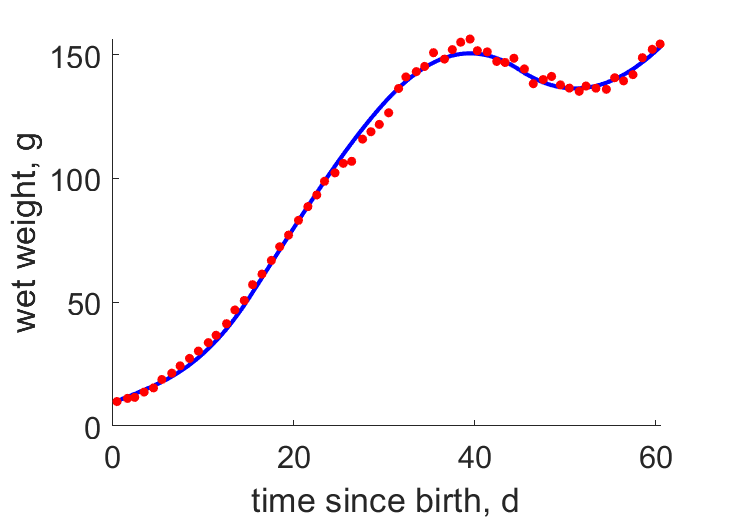Predictions & Data for this entry
| Model: std | climate: Aw | migrate: | phylum: |
| COMPLETE = 2.5 | ecozone: TN | food: biCii, biCvr, biHs | class: |
| MRE = 0.045 | habitat: 0iTi, 0iTf | gender: Dg | order: |
| SMSE = 0.004 | embryo: Tnwfm | reprod: O | family: |
Zero-variate data
| Data | Observed | Predicted | (RE) | Unit | Description | Reference |
|---|---|---|---|---|---|---|
| ab | 16.5 | 17.68 | (0.07152) | d | age at birth | Wiki |
| tx | 42 | 42.31 | (0.007431) | d | time since birth at fledging | ADW |
| tp | 126 | 113.4 | (0.1001) | d | time since birth at puberty | guess |
| tR | 1095 | 1095 | ( 0) | d | time since birth at 1st brood | ADW |
| am | 6022 | 5925 | (0.0162) | d | life span | guess |
| Wwb | 10 | 9.434 | (0.05656) | g | wet weight at birth | LegeVinc2012 |
| Wwi | 155 | 175.2 | (0.1302) | g | ultimate wet weight | LegeVinc2012 |
| Ri | 0.008219 | 0.007964 | (0.03107) | #/d | maximum reprod rate | ADW |
Uni- and bivariate data
| Data | Figure | Independent variable | Dependent variable | (RE) | Reference |
|---|---|---|---|---|---|
| tW |  | time since birth | wet weight | (0.01991) | LegeVinc2012 |
Pseudo-data at Tref = 20°C
| Data | Generalised animal | Pteroglossus torquatus | Unit | Description |
|---|---|---|---|---|
| v | 0.02 | 0.04029 | cm/d | energy conductance |
| p_M | 18 | 602.3 | J/d.cm^3 | vol-spec som maint |
| k_J | 0.002 | 0.02635 | 1/d | maturity maint rate coefficient |
| k | 0.3 | 0.3196 | - | maintenance ratio |
| kap | 0.8 | 0.8588 | - | allocation fraction to soma |
| kap_G | 0.8 | 0.8018 | - | growth efficiency |
| kap_R | 0.95 | 0.95 | - | reproduction efficiency |
Discussion
- scaled functional response turned out to vary in tW data, which has been implemented
- mod_1: v is reduced
- mod_2: Pseudo-data point k is used, rather than k_J; Data set tp and parameter t_R are added, the latter replacing clutch interval t_N. Postnatal T is based on PrinPres1991, see get_T_Aves. See further the revision page, theme puberty
Facts
- Cooperative breeder, with 5-6 adults involved feeding the young (Ref: ADW)
Bibliography